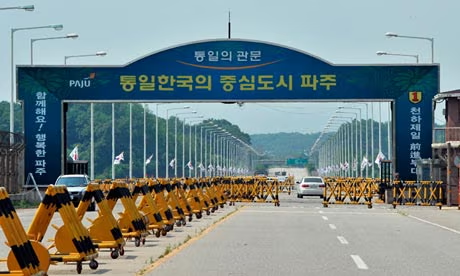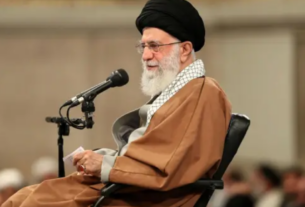In a bold move to intensify its separation from South Korea, North Korea has declared that it will permanently sever all road and railway access between the two countries starting Wednesday. This decision is seen as a significant step towards what the North describes as a “complete separation” of the Korean Peninsula.
The announcement came through the Korean People’s Army (KPA), which stated that the North would “permanently shut off and block the southern border,” while also fortifying its side of the boundary. The KPA labelled this decision as a “self-defensive measure for the inhibiting war,” attributing it to the ongoing joint military exercises between South Korea and the United States, as well as the frequent presence of American nuclear assets in the region. This heightened military presence, they claim, poses a direct threat to North Korean security.
Growing Tensions at a Historic High
This latest move marks an escalation of already high tensions between North and South Korea. Relations between the two have deteriorated to their most strained point in recent years, with several incidents adding to the hostility. The KPA’s statement emphasized that the deteriorating situation on the Korean Peninsula requires North Korea to adopt stronger measures to ensure the safety and security of its nation.
“The acute military situation prevailing on the Korean Peninsula requires the armed forces of the DPRK (Democratic People’s Republic of Korea) to take a more resolute and stronger measure to more creditably defend national security,” the KPA said in a report published by North Korean state media, KCNA.
While the declaration is certainly a provocative one, analysts suggest it is more symbolic than practical. For years, roads and railways connecting the two countries have remained mostly unused, as North Korean authorities have gradually dismantled much of the infrastructure over the past year. Nonetheless, the rhetoric surrounding this decision adds to the deepening divide between the two Koreas.
A Shift in North Korea’s Approach to the South
North Korea’s decision to cut ties with the South isn’t an isolated incident. It follows a series of inflammatory actions over the past several months. These actions have ranged from the North’s frequent missile tests to the launch of balloons filled with propaganda trash, which were sent over the border into South Korea. These actions underscore Pyongyang’s broader strategy to reshape its relationship with Seoul, with an emphasis on asserting its autonomy and independence from its southern neighbour.
The growing hostility is also reflected in North Korean leader Kim Jong-un’s public stance on reunification. At the beginning of 2023, Kim made a significant announcement, stating that his regime was no longer working towards the goal of reunifying the Korean Peninsula. This statement marked a stark departure from previous North Korean policy, which had long emphasized reunification as a national goal. Kim’s comments raised alarms across the region, with many fearing that the shift signalled a potential move towards renewed conflict on the peninsula.
In a speech to North Korea’s Supreme People’s Assembly (SPA) in January, Kim declared that he believed it was necessary to revise key elements of North Korea’s constitution to reflect this new approach. Specifically, he suggested removing phrases such as “northern half” and “independence, peaceful reunification, and great national unity” from the text.
“I think it is necessary to revise some contents of the Constitution of the DPRK,” Kim said at the time. “In my view, it is necessary to delete such expressions in the constitution as ‘northern half’ and ‘independence, peaceful reunification, and great national unity,’” he added, indicating that these changes should be implemented in future sessions.
Uncertainty Surrounds Constitutional Changes
This week, the Supreme People’s Assembly held another session, which concluded on Tuesday. Many experts had expected Pyongyang to formalize Kim’s earlier comments by ratifying constitutional amendments that would officially abandon the goal of reunification. However, no such changes were publicized following the session, leaving analysts and international observers to speculate on North Korea’s next moves.
Some believe that the North could be waiting for the results of the upcoming U.S. presidential election before making any concrete decisions regarding its constitution and border policies. According to Hong Min, an analyst at the Korea Institute for National Unification, Pyongyang may be assessing how to align its strategy with the direction of the next U.S. administration.
“Officials could consider adjusting the extent of constitutional revisions to align with the direction of the new (U.S.) administration,” Hong told AFP, hinting that North Korea’s leadership might be biding its time to see how international dynamics shift in the coming months.
Also Read
Implications of Severing Links with the South
While the official cutting off of roads and railways between North and South Korea may not have an immediate practical impact—given that these routes have been largely non-operational for some time—the symbolism behind the move is significant. It reinforces the message that North Korea is serious about isolating itself from the South and charting its path forward, independent of any reunification efforts or dialogue with Seoul.
Moreover, this action contributes to the broader strategy North Korea has employed over the past year: provoking South Korea and the international community while fortifying its defensive capabilities. By cutting off all direct access routes and bolstering its border defences, Pyongyang is signalling its intent to adopt an even more hardline stance in the ongoing conflict.
This development also adds to concerns about the stability of the region. With North Korea growing more isolated and hostile, and with tensions between the Koreas at their highest point in years, the potential for miscalculation or unintended conflict increases. International stakeholders, particularly the United States, will be closely monitoring the situation to assess how this latest escalation might affect broader geopolitical stability in the region.
Looking Ahead: What Next for the Koreas?
As North Korea continues to shift away from any notion of peaceful reunification and tightens its control over its border with the South, the future of the Korean Peninsula remains uncertain. While Pyongyang’s latest move may be largely symbolic, it serves as a reminder of the unpredictable nature of the regime and its willingness to escalate tensions when it feels threatened.
Moving forward, the international community will be watching for further developments, particularly any constitutional changes that could formalize North Korea’s abandonment of reunification. In the meantime, South Korea and its allies must prepare for a period of heightened tensions and the possibility of more provocative actions from the North.
For now, North Korea’s decision to cut off all roads and railways linking it to the South stands as a stark symbol of the deepening divide between the two nations and the growing risks of renewed conflict on the Korean Peninsula.
For more updates and in-depth coverage on North Korea, South Korea, and other global political developments, visit TTNBC News. Stay informed with the latest news, expert analysis, and insightful commentary on international affairs, all delivered to you by a trusted source. Don’t miss out on breaking stories that matter—explore TTNBC today!





